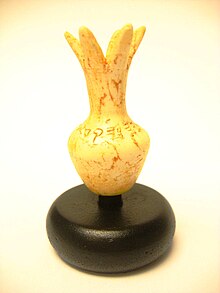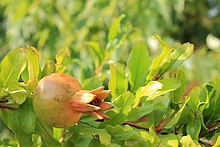Ivory pomegranate
The ivory pomegranate is a 4.3 cm high carved object in the shape of an unripe pomegranate . It is owned by the Israel Museum in Jerusalem and until 2004 was the only remnant from the Solomonic Temple . Today, most experts assume that a forger had inscribed an authentic piece from the Late Bronze Age (without reference to the Jerusalem Temple) with an ancient Hebrew inscription.
description
It is a 4.3 cm high carved pomegranate with a diameter of 2.1 cm. The shape of an unripe pomegranate is shown close to nature. The material is not ivory , but the tooth of a hippopotamus . The flower is damaged. There is a round hole at the bottom so that the object could be put on a stick.
Investigations by the Israel Museum from 2004 on the age of the object revealed an origin from the 13th or 14th century BC. Chr.
inscription
A surrounding ancient Hebrew inscription - the authenticity of which is unlikely according to later investigations - was read as:
לבית [יהו] ה קדש כהנם
l-beyt [yahwe] h qodeš kohanim
and translates:
Holy gift for the priests in the house of [Yahweh],
alternatively also:
To the house of the Lord, holy to the priests.
The house of Yahweh could only refer to the temple in Jerusalem.
Symbolism of the pomegranate
The pomegranate (רמון rimmon) was a frequent decorative motif in the Solomonic Temple (e.g. 1 Kings 7.20 EU ), but also in the ancient Orient as a whole; with its many seeds and bright red color, it symbolized fertility and abundance. Pomegranates are often seen as a decorative element in synagogues and Jewish liturgical objects.
A ceremonial scepter top?
Ceremonial sticks with a pomegranate tip are known from the ancient Orient and would be quite conceivable for a priest in Jerusalem.
history
discovery
André Lemaire , inscription expert at the École pratique des hautes études in Paris, was the first scientist to see the pomegranate: in 1979 in an antique shop in Jerusalem (the price is said to have been $ 3,000). He was able to take a photograph of it and published a short article in a trade journal.
The popular science journal Biblical Archeology Review published by Hershel Shanks took up the subject in 1984. Lemaire published a larger article there: the value of the object rose. As a result, the ivory pomegranate appeared in a Paris exhibition in 1985.
Three years later, the property was offered for sale to the Israel Museum for $ 600,000. The museum had just received a donation of a comparable amount. Based on an expertise by Nahman Avigad , the Israel Museum bought the pomegranate from this collector for $ 550,000 in 1988, although there was no information about the archaeological context from which it came.
Exhibition in the Israel Museum
Apparently the only preserved artefact from the Temple of Solomon, the pomegranate was the highlight of the archaeological exhibition. Small as it was, it was given a special exhibition space and was effectively illuminated. It was a crowd puller for 15 years. The museum described the object: “It probably served as the decorative head of a ceremonial scepter used by the Temple priests during one of the ceremonies.”
According to its symbolic value it was z. B. honored with a stamp in May 1998:
“The right hand shows a drawing of the Temple; it is based on a computerized model designed for the special exhibition at the Bible Lands Museum - 'Jerusalem - A Capital for all Times; Royal Cities of the Biblical World '. The left hand shows a rare inscribed ivory pomegranate exhibited at the Israel Museum, Jerusalem. In the background of the souvenir sheet is a model of the City of David from this exhibition. The pomegranate is inscribed in ancient Hebrew script with the words 'Sacred donation for the Priests (in) the House of ה…' Based on the shape of the characters on the tiny pomegranate (43mm high), the inscription was engraved in the eighth century BCE. The ivory pomegranate may have been used as the head of a scepter of a priest in King Solomon's Temple. The inscription as it appears on the pomegranate decorates the First Day Cover. "
Israeli police investigation
In 2004, antique dealer Oded Golan was charged with counterfeiting ancient artifacts. In his apartment, the police had found soil samples from various excavation sites, seized engraving tools, "half-finished royal seals and inscriptions of all kinds"; the James ossuary was discovered on a toilet seat.
Nevertheless, Golan could not legally prove the application of forged inscriptions. He was acquitted of these charges in 2012 but found guilty of the illegal antiques trade. The judge specifically stated that this did not mean that the artifacts Golan was dealing in were real and authentic.
The long-standing legal proceedings brought some ancient objects with significant inscriptions into the twilight, which came from the antique trade and whose provenance was unclear, including the ivory pomegranate.
Discussions about age
In late 2004, the Israel Museum issued a statement that the carved pomegranate (the authenticity of which has never been questioned) was much older than the Temple of Solomon. It comes from the 13th or 14th century BC. If so, an ancient Hebrew inscription on this artifact cannot be real. The object disappeared from the exhibition.
The Biblical Archeology Review, for which it was also about the good reputation, since it had promoted the popularity of the pomegranate and thus its increase in value, insisted that the object came from the Temple of Solomon.
Discussions on the inscription
Shmuel Ahituv ( Ben Gurion University , Be'er Scheva ) and Aharon Demsky ( Bar Ilan University , Tel Aviv ) expressed doubts about the authenticity of the inscription . It was hoped that this question would be clarified by examining the inscription under a microscope. Achituv was the editor of the Israel Exploration Journal , which published an investigation in 2005 that found the object to be a fake. "The committee argued that some of the letters artificially stopped short of the ancient break on the pomegranate — reflecting the work of a forger."
Lemaire, still convinced of the authenticity, wrote a counter-opinion. He based his argument on traces of patina in the scratched letters.
reception
Yuval Goren spoke ironically of a Jerusalem Syndrome in Biblical Archeology . The scam used by counterfeiters is always the same: a real antique object is provided with an inscription that makes a reference to the Bible. That releases emotions. For many visitors to the Israel Museum, the encounter with the pomegranate was a kind of religious experience.
In the world of counterfeiters there are experts who are just as familiar with epigraphy as the experts in museums and universities. An inscription with interesting content multiplies the value of the ancient object. Museums tend to be the buyers of the forgeries by chance. The counterfeiters target private collectors who are willing to pay high sums for objects from biblical times.
literature
- Irène Lewitt (Ed.): The Israel Museum Jerusalem , Jerusalem 1995, ISBN 1-85669-068-7 , p. 66.
- Julia Serr: The fight for the antique market. How modern forgers are shaking the Israeli antiquities law . In: World and Environment of the Bible 1/2015, pp. 76–79.
Web links
- Biblical Archeology Review: Is the Ivory Pomegranate a Forgery or Authentic?
- Biblical Archeology Review: Leading Israeli Scientist Declares Pomegranate Inscription Authentic
- Yuval Goren : The Jerusalem Syndrome in Biblical Archeology
Individual evidence
- ^ Joan Poulin / Jacques Briend: The Holy Land in the museums of Jerusalem . In: World and Environment of the Bible . No. 4 , 1997, p. 82 .
- ↑ Julia Serr: The fight for the antique market . S. 76 .
- ↑ Eric H. Cline: Biblical Archeology. A very short introduction . Oxford University Press, 2009, pp. 116 .
- ↑ BBC News Middle East: Ivory pomegranate 'not Solomon's'. December 24, 2004, accessed December 17, 2017 .
- ↑ Julia Serr: The fight for the antique market . S. 76 .
- ↑ Chaim Guski: Rimonim. Religious terms from the world of Judaism. In: Jüdische Allgemeine. November 21, 2013, accessed December 18, 2017 .
- ^ André Lemaire: Une inscription paleo-hébraïque sur grenade en ivoire . In: Revue Biblique 88, 1981, pp. 236-239.
- ^ Israel Museum Jerusalem: Ivory pomegranate . S. 66 .
- ^ Israel Philatelic Federation: World Stamp Exhibition - Israel 98, King Solomon's Temple. Retrieved December 18, 2017 .
- ↑ Julia Serr: The fight for the antique market . S. 78 .
- ↑ BBC News Middle East: Ivory pomegranate 'not Solomon's'. December 24, 2004, accessed December 17, 2017 .
- ↑ Julia Serr: The fight for the antique market . S. 76 .
- ↑ Ivory Pomegranate Revisited: A Relic from Solomon's Temple? Retrieved December 17, 2017 .


